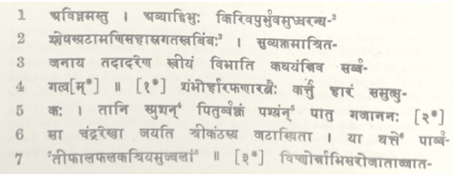|
The Indian Analyst
|
North Indian Inscriptions |
VANAPALLI PLATES OF ANNA-VEMA. (vv. 13, 16, 17, 18, 20 and 21), Ana-Vêma (vv. 19 and 28) or (in Telugu) Ana-Vêma (l. 65). The second of these resided at Koṇḍavîṭî (v. 14), i.e. Koṇḍavîḍu, and bore the surnames Jaganobbagaṇḍa (v. 13), Kshurikâ-Kali-Vêtâla and Karpûra-Vasantarâya (v. 19). Two references to Hêmâdri (vv. 9 and 11) show that his Dânakhaṇḍa was considered an authority at the time of the grant. ......The immediate object of the inscription is to record that king Anna-Vêma granted a village as an agrahâra to a certain Immaḍi of the Lôhita gôtra (v. 21), who was the son of the minister Mallaya (v. 23) and appears to have been the minister (v. 22) and spiritual preceptor (v. 24) of the king. The date of the grant was the fourteenth tithi of the dark fortnight of Mâgha in the cyclic year Siddhârthin and the Śaka year 1300 (v. 21). The Siddhârthi-saṁvatsara does not correspond with Śaka-Saṁvat 1300, but with 1301 expired or 1302 current (A.D. 1379-80). Mr. Dikshit kindly informs me that the European equivalent of the date is Monday, the 6th February, A.D. 1380. The granted village was named Immaḍilaṅka (vv. 21, 24, 27 and 28) after the donee, and also Anna-Vêmapura (v. 24) after the donor. The western boundary of the granted village was the Gautamî (v. 26), which may mean either the Gôdâvarî river in general, or its northern branch below the present Anicut. Mr. Gopalam, the discover of the inscription, remarks that Vanapalli, where the plates were found, “lies on the southern side of the Gautamî, a branch of the Gôdâvarî, and there is a hamlet called Immaḍivârilaṅka to the north of the village.” The southern boundary of Immaḍilaṅka is stated to have been “a straight line (?) between a pîpal tree on a platform (?) in the village of Prakhyâ and the house of Mugguḷḷasanda” (v. 25 f.). Mr. Gopalam says :― “There are two villages, called Prakkilaṅka and Mugguḷḷa, above the Anicut, and I entertain some doubt whether the inscription under enquiry relates to any grant near those villages.” If this is really the case, the granted village of Immaḍilaṅka cannot be identical with the modern Immaḍivârilaṅka, which is not above, but below the Anicut. I am unable to say which of these two possibilities is correct, nor have I any means for identifying the boundaries in the east (Kriddêvî, v. 25) and in the north (Koṇḍûrî and Koṇḍepûṇḍî, v. 26).
......After the usual imprecatory verses follow two verses in which the composer of the inscription, Trilôchanârya, praises his own poetical merits (v. 28 f.). The document ends with an invocation of Śiva and with the signature of the king. TEXT.1
| ||||||||||||||||||||||||||||||||||||||||||||||||||||||||||||||||||||||||||||
| > |
|
>
|









